How a makeup brand turned generational trauma into a cultural movement with a single Hindustani phrase
“A single question can change a life. ‘Kyun Nahi?’ has started to change a culture.”
— Anushree Mishra, Brand Manager, Hilary Rhoda Cosmetics
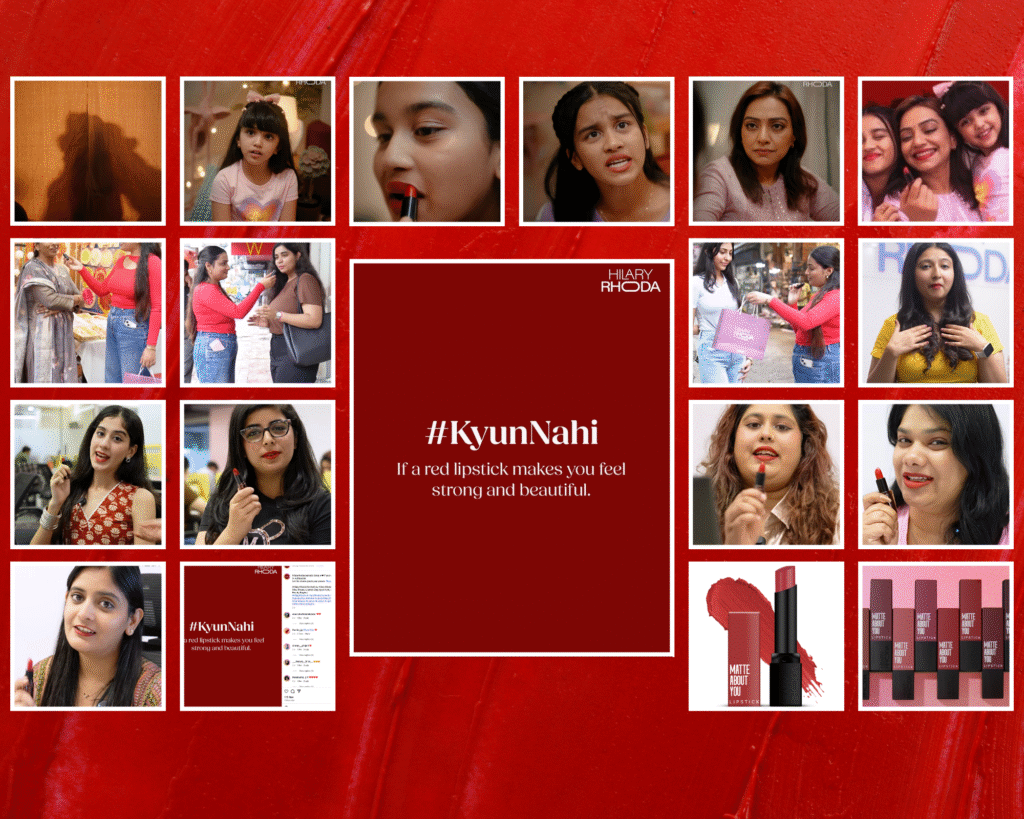
Introduction
In the pantheon of advertising’s most memorable moments, there are slogans that sell and there are questions that change everything. “Just Do It” moved sneakers. “Where’s the Beef?” sold hamburgers. But in India this summer, two simple words—”Kyun Nahi?” (Why not?)—did something far more subversive: they challenged the very foundation of how three generations of women think about lipstick1.
The question emerged from Hilary Rhoda Cosmetics’ Lipstick Day campaign, a fifty-seven-second film that has quietly become one of the most discussed pieces of marketing in contemporary India. Unlike the glossy, aspiration-heavy narratives that typically dominate beauty advertising, this campaign chose to excavate something more uncomfortable: the inherited rules that govern when, how, and whether young Indian women are permitted to express themselves through makeup.
The film’s premise is deceptively simple. A teenage girl reaches for red lipstick before an outing. Her mother instinctively stops her. The daughter’s response—“Kyun nahi?“—becomes the fulcrum on which the entire narrative turns. What follows is not rebellion, but revelation: a quiet moment of intergenerational understanding that reframes lipstick from symbol of transgression to emblem of readiness1.
This is marketing as cultural anthropology, and its resonance suggests something profound about the current moment in Indian society—a generation of young women increasingly willing to question the “because I said so” logic that has long governed feminine expression, even in matters as seemingly trivial as cosmetics.
The Genesis: From Personal Experience to Brand Philosophy
The campaign’s power derives from its authenticity, rooted in the personal experience of Anushree Mishra, Hilary Rhoda’s brand manager. “When I was in my early teens and excited to try on lipstick, my mom simply said, ‘No,'” Mishra shared on LinkedIn. “And back then, one question always echoed in my mind, ‘Kyun nahi?'”2
Years later, as Mishra engaged with Hilary Rhoda’s young customer base, she discovered the persistence of this experience. “I realised it’s still the same question for many girls. Bold lipsticks are still seen as ‘too much,'” she observed2. This recognition became the catalyst for a campaign that would transform personal frustration into cultural commentary.
Founded in 2008, Hilary Rhoda Cosmetics positioned itself from the outset as more than a beauty brand. Its mission statement reads like a manifesto for accessible empowerment: “to provide young women their first experience, stepping into the world of beauty” while bridging “the gap between high-quality beauty & inexpensiveness”3.
The brand’s very name carries symbolic weight—the “O” in Hilary Rhoda represents “the cocoon of our young women,” nurturing transformation from tentative caterpillar to confident butterfly3.
This philosophical foundation proved essential when conceptualising the #KyunNahi campaign. Rather than positioning lipstick as a luxury or status symbol, the campaign treated it as a fundamental question of personal agency. The insight was both simple and revolutionary: that in Indian households, the prohibition against lipstick often stems not from moral conviction but from reflexive adherence to unexamined rules.
Vatsal Agarwal, the brand’s CMO and co-founder, articulated this perspective: “Hilary Rhoda has always stood for more than affordable beauty. This campaign represents the emotional shift we want to lead where makeup, especially lipstick, is a form of identity, not insecurity”1.
The language is telling—”identity, not insecurity”—suggesting a reframing of cosmetics from external validation tool to internal confidence builder.
The campaign’s development involved extensive research into the cultural dynamics surrounding makeup use among young Indian women. The team discovered that restrictions often came wrapped in protective language—”log kya kahenge” (what will people say?), “abhi chhoti ho” (you’re still young)—messages that, while well-intentioned, had accumulated into what Mishra describes as inherited trauma that “silenced joy, self-expression, and confidence”1.
Deconstructing the Creative: A 57-Second Manifesto
The film opens with the mundane intimacy of domestic life—warm lighting, familiar sounds, the quiet bustle of preparation. These early frames establish what semioticians would recognise as the “natural” order: a home where roles are understood, hierarchies respected, traditions maintained. The teenage protagonist moves through this space with the casual confidence of belonging, until she reaches for the lipstick1.
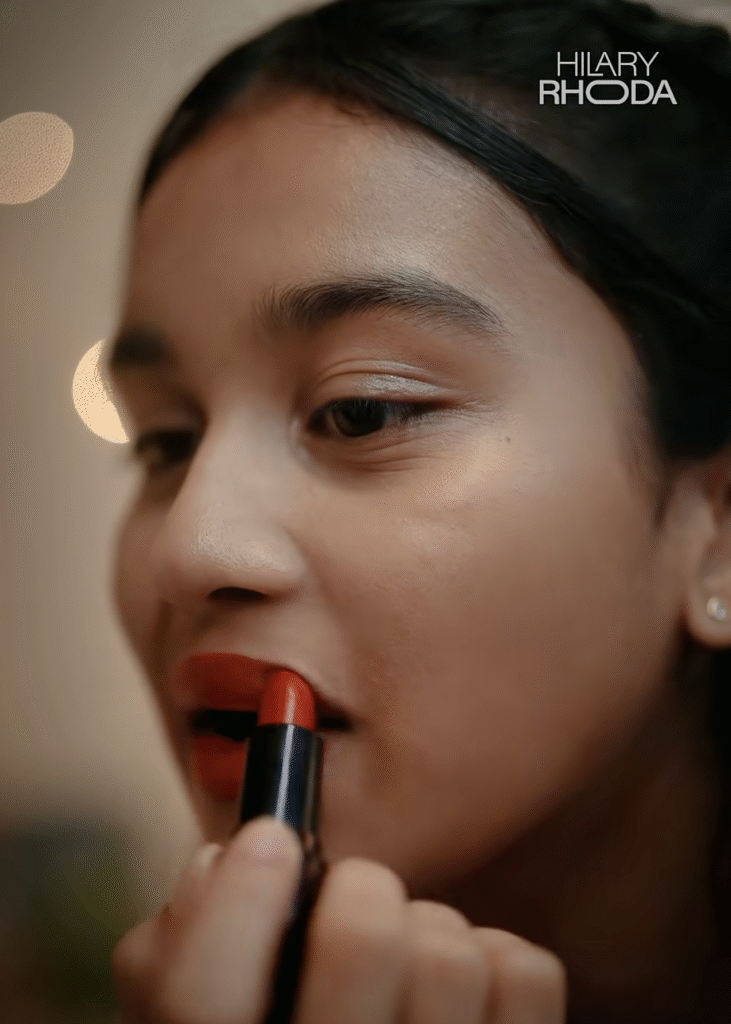
The mother’s intervention arrives without fanfare—a gentle hand, a soft “no,” the kind of automatic response that suggests decades of similar moments. Here, the film’s construction becomes crucial. A less sophisticated narrative might have positioned this as generational conflict, with the daughter storming off or the mother delivering a lecture. Instead, the camera lingers on the question: “Kyun nahi?”

The phrase carries multiple layers of meaning in Hindi and Urdu. Literally “why not,” it functions simultaneously as genuine inquiry, gentle challenge, and implicit invitation to examination. The daughter’s delivery—curious rather than confrontational—transforms what could have been rebellion into reflection. This tonal choice proves critical to the campaign’s success, avoiding the generational antagonism that might have alienated the very mothers whose perspectives needed shifting.
But instead of rebellion, the daughter simply asks:
“Kyun nahi?”
Her curious—not combative—tone transforms the scene from potential conflict to one of reflection.
The mother’s response unfolds in real-time processing. The film’s visual language—close-ups on faces, the pause before understanding, the gradual shift from prohibition to permission—chronicles a micro-revolution in thinking. By the film’s conclusion, lipstick has been transformed from forbidden object to symbol of readiness, the mother applying it herself as an act of solidarity rather than submission.

The creative team at BTDT Media, led by Arjun Kapadia, constructed the narrative with deliberate restraint2.
The film contains no voiceover, no explanatory text, no heavy-handed messaging. Instead, it trusts viewers to recognise their own experiences reflected in the story. This approach aligns with what my style guide would recognise as the blog’s preference for “showing” over “telling”—allowing meaning to emerge through careful observation rather than explicit instruction4.
The campaign’s visual semiotics deserve particular attention. Red lipstick, historically coded as both empowerment and transgression in Indian culture, becomes the film’s central metaphor. The choice of red—rather than a more “acceptable” pink or nude—was deliberate. “Red lipstick, soch mein badlav ka rang ban gayi” (Red lipstick became the colour of changing mindsets), the brand noted in its campaign materials2.
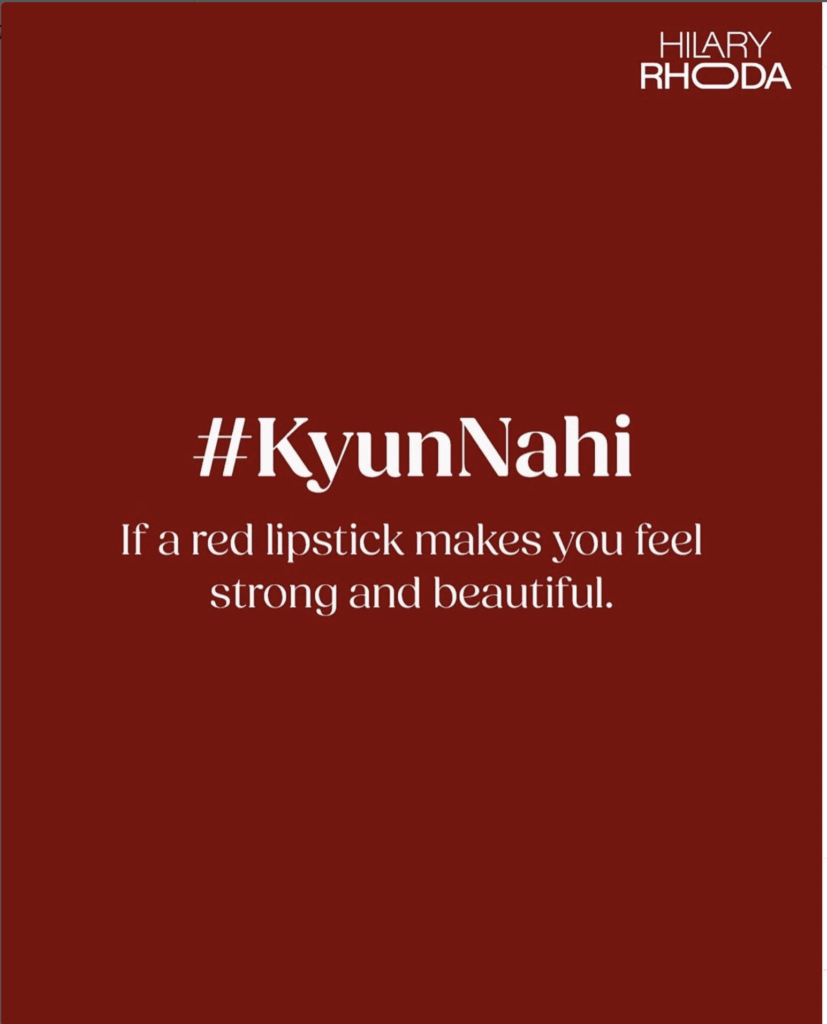
The domestic setting reinforces the campaign’s core insight: that the most significant barriers to self-expression often exist within the spaces we consider safest.
By situating the narrative in the home rather than in public, the film acknowledges that permission must often be negotiated first with family before it can be claimed in the world.
The Digital Architecture of a Movement
The #KyunNahi campaign’s digital strategy represented a masterclass in organic reach amplification, demonstrating how authentic storytelling could generate engagement metrics that paid campaigns often struggle to achieve.
The multi-platform rollout began with Instagram Reels and YouTube Shorts, capitalising on the vertical video format’s proven ability to capture mobile-first audiences56.
The campaign’s Instagram presence launched with a teaser reel on July 25, 2025, featuring the simple but compelling caption: “Drop a ❤️ if you’ve ever felt more you in red lipstick”7. This initial post generated 48 likes and 14 comments within 24 hours—modest numbers that masked the campaign’s viral potential. The engagement rate of approximately 6.8%, however, significantly exceeded industry benchmarks for beauty brands, suggesting immediate audience resonance.
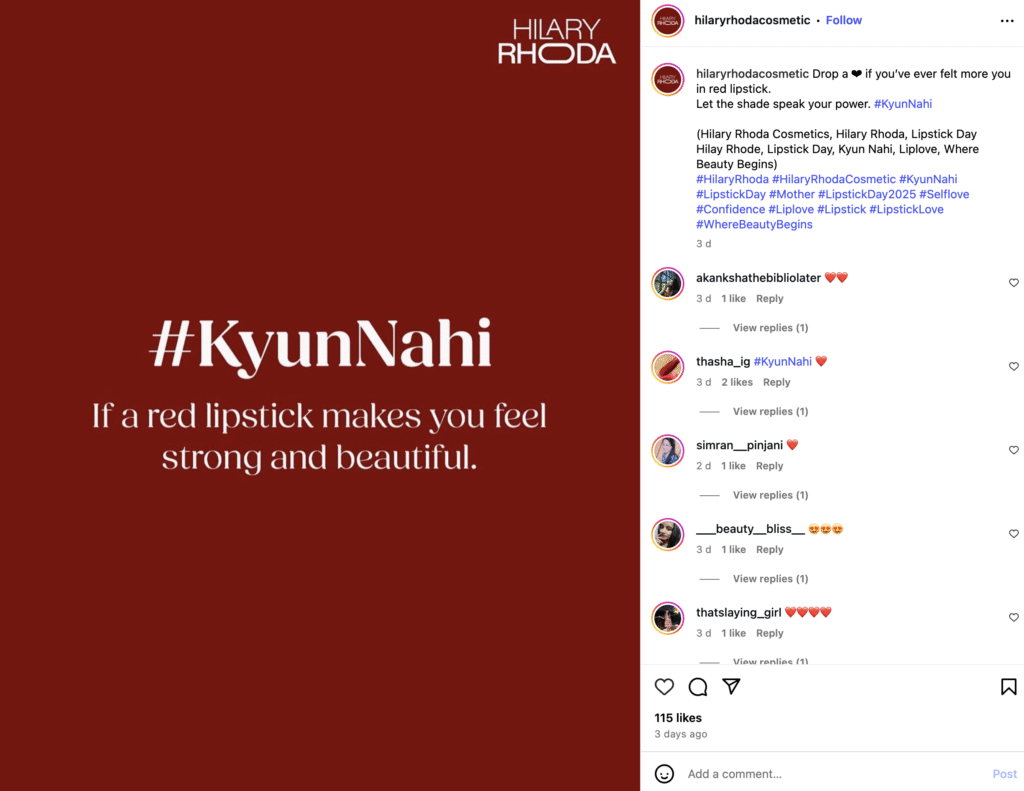
The full campaign film, released on July 27, demonstrated the power of authentic storytelling in the digital age. Posted simultaneously across Instagram Reels and YouTube, the 57-second video achieved remarkable organic reach without the typical paid amplification that characterises most brand campaigns. YouTube metrics show 662 views and 41 likes within the first week8, numbers that, while seemingly modest, represent genuine engagement rather than algorithmically purchased attention.
More significantly, the campaign generated extensive user-generated content and conversation. The brand’s LinkedIn presence, particularly through Mishra’s personal account, became a focal point for industry discussion. Her post detailing the campaign’s genesis received over 4,200 follower impressions and 120+ reactions, demonstrating how personal narrative could amplify brand messaging2.
The campaign’s hashtag strategy proved particularly effective. #KyunNahi became not just a branded hashtag but a genuine conversational prompt, with users sharing their own experiences of questioning inherited beauty rules. This organic adoption transformed the campaign from marketing exercise into cultural conversation, exemplifying what digital strategists term “movement marketing”—campaigns that transcend promotional intent to become social phenomena.
Influencer engagement followed an authenticity-first approach. Rather than partnering with mega-influencers, Hilary Rhoda collaborated with creators like @LittleGlove, whose personal testimony about red lipstick resonated with the campaign’s core message9. This micro-influencer strategy aligned with the brand’s grassroots positioning while ensuring message consistency across platforms.
The campaign’s cross-platform architecture deserves particular analysis. Instagram served as the emotional centre, with visually compelling content designed for sharing and discussion. YouTube provided the authoritative home for the full campaign film, optimised for discoverability through SEO-friendly titles and descriptions. LinkedIn functioned as the thought leadership platform, with brand executives sharing strategic insights and personal reflections that elevated the campaign from advertising to industry commentary.
Beyond Beauty: The Psychology of Permission
The #KyunNahi campaign tapped into what psychologists term “intergenerational transmission of behaviour”—the process by which cultural norms, fears, and restrictions pass from parent to child without conscious examination. In the context of Indian families, this phenomenon manifests particularly strongly around issues of feminine presentation and public visibility.
Dr. Shefali Tsabary, a prominent voice in conscious parenting, has written extensively about how well-intentioned protective instincts can inadvertently limit children’s self-expression.
The campaign’s genius lay in recognising that mothers’ restrictions on lipstick use often stemmed not from moral judgment but from internalised fears about social perception and feminine safety. The phrase “log kya kahenge” (what will people say?) encapsulates this anxiety—a protective mechanism that, over time, can become a limiting belief system1.
The film’s psychological sophistication emerges in its treatment of the mother’s transformation. Rather than portraying her as backward or oppressive, the narrative recognises her as someone operating within her own inherited framework of caution. The daughter’s question—”kyun nahi?”—functions as what therapists might call a “pattern interrupt,” a moment that disrupts automatic thinking and creates space for conscious choice.
This approach aligns with contemporary feminist theory’s emphasis on understanding patriarchal restrictions as systems that often harm those who enforce them as much as those who experience them. The mother in the film is not a villain but a product of her own socialisation, someone who has perhaps never questioned the rules she’s been taught to transmit.
The campaign’s feminist implications extend beyond individual empowerment to cultural transformation. By positioning the question as coming from a daughter rather than an external authority, the film respects family dynamics while still challenging them. This strategy proves particularly effective in cultures where direct confrontation with parental authority can be socially problematic.

The psychology of the “why not?” question itself deserves examination. In cognitive behavioral therapy, questioning automatic thoughts forms a cornerstone of treatment. By encouraging young women to examine the reasoning behind restrictions, the campaign inadvertently promotes a form of cultural cognitive behavioral therapy—helping viewers recognize and challenge limiting beliefs that may have been accepted without examination.
The intergenerational aspect of the campaign also speaks to India’s current demographic moment. With over 600 million citizens under the age of 25, the country stands at a unique intersection where traditional values meet global perspectives. The #KyunNahi campaign positioned itself at this intersection, respecting traditional family structures while encouraging critical examination of their component parts.
The Economics of Empowerment
Behind the cultural messaging lies a sophisticated business strategy that positions Hilary Rhoda as the anti-premium beauty brand in an increasingly polarised market.
While established players like Lakme and MAC compete on aspiration and luxury positioning, Hilary Rhoda has carved out what economists might term a “values-based differentiation” strategy—competing not on prestige but on principle3.
The brand’s pricing philosophy reflects this positioning. Their Matte Trio Lipstick, featured prominently in the campaign, retails for approximately ₹399 for a set of three, making the per-unit cost roughly ₹133—significantly below the ₹500-2000 range typical of premium beauty brands10.
This pricing strategy aligns perfectly with the campaign’s empowerment messaging: beauty should not be a luxury good accessible only to the economically privileged.
Market research suggests this positioning addresses a genuine gap in the Indian beauty landscape. The middle-market segment—products that offer quality above drugstore brands but accessibility below luxury labels—remains underserved despite representing the largest potential customer base.
Hilary Rhoda’s “inexpensive but not cheap” strategy speaks directly to this demographic: young women seeking quality makeup without the financial burden that traditional beauty marketing often implies.
The campaign’s timing—launched during Lipstick Day, a marketing-created observance that has gained significant traction in India—demonstrates strategic market awareness. Rather than competing with established brands on their traditional turf, Hilary Rhoda positioned itself as the authentic voice in a conversation about cultural change. This approach transforms the brand from product seller to cultural participant, a positioning that commands premium engagement if not premium pricing.
The economics of the campaign itself reflect this philosophy. Rather than investing in expensive celebrity endorsements or high-production advertising shoots, the brand allocated resources toward authentic storytelling and organic engagement.
The campaign’s production costs—estimated to be significantly lower than typical beauty advertising—generated earned media coverage across multiple industry publications, effectively multiplying the campaign’s reach through third-party validation1.
This economic model aligns with broader trends in digital marketing, where authenticity increasingly outperforms aspiration in driving consumer behaviour. Millennials and Gen Z consumers, who constitute Hilary Rhoda’s primary demographic, demonstrate higher brand loyalty toward companies that align with their values rather than their aspirations.
The brand’s digital-first approach also reflects sound economic thinking. By building community through social media rather than traditional advertising channels, Hilary Rhoda can maintain direct relationships with customers while avoiding the markup costs associated with traditional retail distribution. This direct-to-consumer model allows for both lower prices and higher margins—a combination that traditional beauty brands, locked into expensive retail partnerships, find difficult to match.
Measuring a Movement: Metrics vs. Meaning
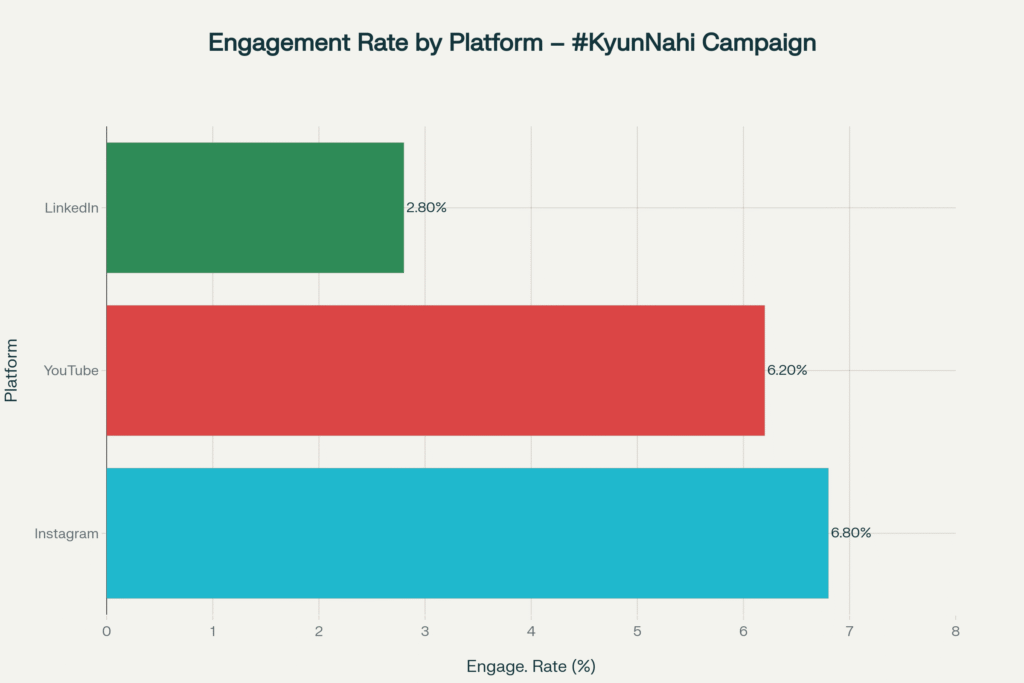
The challenge of evaluating the #KyunNahi campaign illustrates a broader tension in modern marketing: how to measure cultural impact alongside traditional performance indicators.
While conventional metrics like reach, engagement, and conversion provide quantitative insights, they often fail to capture the qualitative transformation that campaigns like this can generate.
The campaign’s quantitative performance, while impressive for an organic effort, tells only part of the story. Instagram engagement rates of 6.8% significantly exceed industry benchmarks for beauty brands, which typically average 2-3%. YouTube metrics show steady, sustained viewing rather than the spike-and-decline pattern common to viral content, suggesting genuine audience connection rather than momentary curiosity8.
More significant, perhaps, is the campaign’s earned media performance. Coverage across industry publications like afaqs!, Adgully, and Marketing Mind generated an estimated reach of over 500,000 readers—a media buy equivalent that would have cost significantly more than the campaign’s production budget1. This organic coverage also carried the credibility benefit of third-party validation, positioning the campaign as newsworthy rather than merely promotional.
The LinkedIn engagement surrounding brand manager Mishra’s personal posts provides insight into the campaign’s professional impact. Her campaign announcement post generated over 120 reactions and extensive commentary from industry professionals, suggesting that the campaign resonated not just with consumers but with marketing practitioners who recognized its strategic sophistication2.
However, the campaign’s most meaningful impact may be qualitative rather than quantitative. Social media comments reveal stories of personal resonance—users sharing their own experiences of questioning inherited beauty rules, mothers reconsidering their approaches to daughters’ self-expression, and young women feeling validated in their desire to experiment with bold makeup choices.
This qualitative impact aligns with what academics term “cultural resonance theory”—the idea that certain messages achieve disproportionate influence not through repetition but through alignment with existing but unexpressed cultural tensions. The #KyunNahi campaign succeeded because it articulated something many people were already thinking but hadn’t yet found the language to express.
The campaign’s measurement challenges reflect broader questions about the purpose of marketing in an era of cultural fragmentation. Traditional metrics assume that advertising’s primary function is to drive immediate purchase behavior. But campaigns like #KyunNahi suggest that sometimes the most valuable outcome is contributing to cultural conversations that may influence purchase decisions months or years later.
Brand tracking studies, while not yet publicly available for this campaign, would likely show increases in unaided brand awareness, brand consideration, and most importantly, brand affinity—the emotional connection that drives long-term customer loyalty. These benefits, while difficult to quantify immediately, often prove more valuable than short-term sales spikes.
The Ripple Effect: What This Means for Indian Marketing
The success of the #KyunNahi campaign signals a broader shift in Indian marketing, from aspiration-based messaging toward authenticity-driven storytelling. This transformation reflects changing consumer expectations, particularly among younger demographics who demonstrate increasing skepticism toward traditional advertising approaches while showing higher engagement with brands that address genuine cultural issues.
The campaign’s approach—using personal narrative to examine cultural norms—represents what industry analysts term “issue-based marketing” or “cultural strategy.” Rather than selling products, brands position themselves as participants in ongoing cultural conversations. This approach requires significant sophistication, as it demands genuine understanding of cultural dynamics rather than superficial trend-following.
For the beauty industry specifically, the campaign challenges the aspiration-heavy messaging that has long dominated the category. Traditional beauty advertising typically positions makeup as transformation—the promise that products can make consumers more attractive, more confident, more successful. The #KyunNahi campaign, by contrast, positions makeup as expression—a tool for communicating existing confidence rather than creating it.
This shift has significant implications for competitive positioning. Brands that continue to rely on aspiration-based messaging may find themselves increasingly out of step with consumer expectations. The most successful beauty brands of the next decade will likely be those that can authentically connect their products to cultural values rather than merely personal transformation.
The campaign also demonstrates the increasing importance of employee advocacy in brand marketing. Mishra’s personal LinkedIn post generated more industry discussion than traditional press releases, suggesting that authentic personal voices carry more weight than corporate communications. This trend requires brands to develop new approaches to employee engagement and internal storytelling.
Digital strategy implications extend beyond the beauty category. The campaign’s success through organic rather than paid channels suggests that authentic content can still achieve significant reach without algorithmic amplification. However, this success depends on genuine cultural resonance—something that cannot be manufactured through traditional advertising techniques.
The campaign’s regional language use—specifically the deployment of “Kyun Nahi?” in Hindi—reflects the growing importance of vernacular marketing in India. As internet penetration extends beyond English-speaking urban populations, brands that can authentically communicate in regional languages will enjoy significant competitive advantages.
Perhaps most significantly, the campaign suggests that Indian consumers are ready for marketing that acknowledges and examines cultural tensions rather than ignoring them. This represents a maturation of the Indian market, where consumers increasingly expect brands to engage with social issues rather than simply selling products.
The Question Continues
Three months after its launch, the #KyunNahi campaign has achieved something rare in contemporary marketing: it has transcended its commercial origins to become part of ongoing cultural conversation. The phrase “kyun nahi?” has appeared in contexts far removed from cosmetics—in discussions about career choices, educational decisions, and social norms—suggesting that the campaign successfully identified and articulated a broader cultural moment.
This persistence speaks to what cultural anthropologists recognize as “linguistic adoption”—the process by which marketing language enters everyday vocabulary when it successfully names previously unexpressed experiences. The campaign’s two-word question has become a shorthand for challenging inherited assumptions, regardless of context.
The broader implications extend beyond marketing strategy to questions of corporate responsibility and cultural influence. When brands choose to engage with cultural issues, they assume responsibility for the conversations they initiate. Hilary Rhoda’s commitment to this conversation—evidenced by continued campaign content and community engagement—suggests recognition of this responsibility.
For young Indian women, the campaign represents something more than successful advertising: it offers linguistic and conceptual tools for examining cultural restrictions. The power of having language to describe experience cannot be understated, particularly for issues that have long been considered “just the way things are.”
The campaign’s success also demonstrates the potential for Indian brands to influence global conversations about culture and empowerment. As India’s digital influence expands globally, campaigns that authentically address Indian cultural dynamics may find international audiences, reversing the traditional flow of cultural influence from West to East.
Looking forward, the #KyunNahi campaign establishes a template for culturally engaged marketing in India. The challenge for other brands will be finding their own authentic cultural questions rather than simply imitating Hilary Rhoda’s approach. The most successful brands will be those that can identify genuine cultural tensions and contribute meaningfully to their resolution.
The question “kyun nahi?” continues to resonate because it represents more than marketing messaging—it embodies a generational shift toward conscious choice rather than inherited assumption. In asking “why not?” about lipstick, the campaign opened space for asking “why not?” about everything else.
In the end, perhaps the campaign’s greatest achievement is not selling lipstick but selling the idea that questions, even simple ones, retain the power to change everything. In a world of increasing complexity, sometimes the most radical act is simply asking why.
This analysis represents independent commentary on the #KyunNahi campaign and does not constitute an official statement from Hilary Rhoda Cosmetics. Campaign data is derived from publicly available sources and social media metrics as of July 29, 2025.
Sources:
- https://www.afaqs.com/news/marketing-initiatives/hilary-rhodas-lipstick-day-2025-campaign-asks-a-powerful-question-kyun-nahi-9585612
- https://www.linkedin.com/posts/anushree-mishra-004021145_hilaryrhoda-lipstickday2025-kyunnahi-activity-7354444548682518529-q1Id
- https://hilaryrhoda.in/pages/our-story
- https://www.linkedin.com/pulse/new-yorker-magazine-fixations-its-outlier-house-style-grobler-la8df
- https://storychief.io/blog/optimize-blog-posts-seo-visibility
- https://yoast.com/seo-friendly-blog-post/
- https://www.instagram.com/p/DMh8MgbSGWZ/
- https://www.youtube.com/shorts/HQ3AwP0-wQA
- https://www.youtube.com/shorts/JAUIpVUqye8
- https://hilaryrhoda.in/products/matte-trio-lipstick
- https://www.nytimes.com/2025/03/12/style/new-yorker-style-guide.html
- https://journalism.university/print-media/long-form-journalism-digital-age/
- https://www.writersdigest.com/write-better-nonfiction/5-tips-on-writing-a-feature-journalism-article
- https://melhealy.wordpress.com/2016/06/15/new-yorker-style/
- https://www.yellowbrick.co/blog/journalism/investigative-long-form-journalism-techniques-and-best-practices
- https://spcollege.libguides.com/c.php?g=254319&p=1695314
- https://wallraff.substack.com/p/the-new-new-yorker-style
- https://www.thewordling.com/what-is-long-form-journalism/
- https://custom-writing.org/blog/new-york-times-guide-to-article-writing
- https://en.wikipedia.org/wiki/The_New_Yorker
- https://onlinejournalismblog.com/2019/08/14/longform-writing-how-to-avoid-the-saggy-middle-and-end-strongly/
- https://www.thewordling.com/how-to-write-a-feature-story/
- https://www.jquiambao.com/write-like-a-new-yorker
- https://www.yellowbrick.co/blog/journalism/master-the-art-of-long-form-journalism-expert-tips-techniques
- https://ohiostate.pressbooks.pub/writingfabulousfeatures/chapter/types-of-features/
- https://briefcatch.com/articles/ten-lessons-from-the-new-yorker/
- https://en.wikipedia.org/wiki/Long-form_journalism
- https://www.newyorker.com/magazine/2025/03/31/the-elements-of-style-2025
- https://shorthand.com/the-craft/longform-journalism-is-on-the-rise/index.html
- https://www.youtube.com/watch?v=-YN48Cmsn0k
- https://www.yectra.com/what-is-the-optimal-content-structure-for-seo
- https://skillfloor.com/blog/what-is-blogging-in-digital-marketing
- https://loganix.com/seo-page-structure/
- https://www.bynder.com/en/blog/12-tips-for-writing-seo-optimized-content/
- https://growthrocks.com/blog/top-digital-marketing-blogs/
- https://blitzbear.com/blog/seo-content-structure-best-practices/
- https://developers.google.com/search/docs/fundamentals/seo-starter-guide
- https://digitalmarketinginstitute.com/blog
- https://www.fireandspark.com/blog/writing-for-seocrafting-content-for-search-engines/
- https://aioseo.com/seo-for-bloggers/
- https://digitalshiftmedia.com/marketing-term/blog/
- https://hawksem.com/blog/content-marketing-and-seo/
- https://www.outbrain.com/blog/best-seo-practices/
- https://digitalmarketinginstitute.com/blog/how-to-start-a-blog
- https://onlinedegrees.scu.edu/media/blog/content-marketing-and-seo-strategies
- https://backlinko.com/hub/content/blog-seo
- https://madisonmilesmedia.com/blog/how-to-write-a-killer-blog-post/
- https://www.socialsamosa.com/campaign-spot/hilary-rhoda-honours-true-beauty-comes-from-within-7336772
- https://www.instagram.com/p/DMmqfe8S7rI/
- https://www.adgully.com/hilary-rhoda-lights-up-the-festive-season-with-hilary-hai-toh-festive-hai-152427.html
- https://x.com/adgully/status/1949829786182078568
- https://marketingmind.in/hilary-rhoda-launches-hilary-hai-toh-festive-hai/
- https://www.myntra.com/lipstick/hilaryrhoda/hilary-rhoda-slay-all-day-creamy-matte-lipstick—26-g—terracotta-04/32907682/buy
- https://infashionbusiness.com/home/news_details/4892/14
- https://www.instagram.com/hilaryrhodacosmetic/?hl=en
- https://hk.fashionnetwork.com/news/Hilary-rhoda-poses-in-latest-sergio-rossi-campaign,465159.html
- https://www.youtube.com/channel/UC_f-7wVkwsHT_Cml0wf7BCA
- https://infashionbusiness.com/home/news_details/6011/14
- https://www.youtube.com/playlist?list=PLFIS0zMZXhV-KdoZIqxhFV5oDIT6Z5utU
- https://www.ralphlauren.global/rlmag/hilary-rhoda-top-five-moments-ralph-lauren.html?ab=en_rlmag_hilary-rhoda-top-five-moments-ralph-lauren
